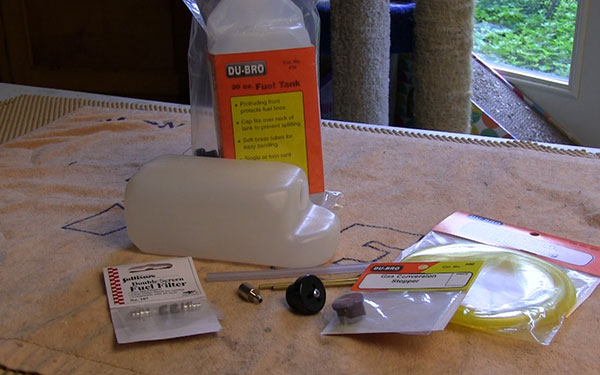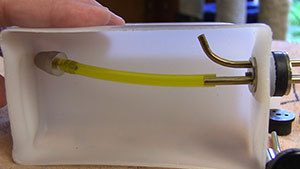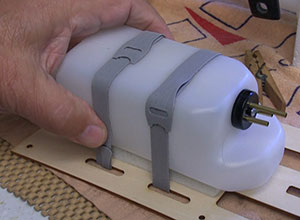



I often buy two of everything I need for installing tanks so I have stuff for the next
plane.
Text, photos and video by Tom Hintz
Flight video by Clark Ponthier
Posted – 6-29-2017
The information here applies mainly to gasoline-based fuel systems. However, much of this info applies to glow fuel systems apart from the pressure line from the muffler to the tank that is common in glow engines because they do not have a pumping carburetor as do most gasoline systems.
When I got into RC aircraft needing to understand fluid dynamics or hydraulics never crossed my mind. To be sure, we are talking a truly basic understanding of these principles but they remain important for the model fuel system to function correctly throughout a flight.
Most modern fuel tanks designed for model aircraft are compatible with gasoline fuels. Some need a special stopper or other interior plumbing component and those needs should be on the label or in the product description. For example, the popular Du-Bro fuel tanks need a special stopper and a replacement for the internal fuel lines to be fully compatible with gasoline. That adds a couple dollars to the overall cost of the tank but I can accept that price for a consistent fuel delivery system.
The capacity of the tank for a given application is difficult for me to get specific with. That is mostly because I am terrible at guessing how much fuel a given plane will need for a decent flight time. My best advice here is to look around where you fly and see what tank capacity others are using for similarly sized engines. You also must consider how they fly as compared to your style. Harder flying takes considerably more fuel than does someone that reduces throttle to 50% or so after takeoff. For our purposes, I am using a 16oz Du-Bro tank that needed a replacement gasoline-compatible stopper.
A common problem is a clunk line that
is too long and hangs up on the back of
the tank. Dead sticks will follow.
Locating the fuel tank is simple. Usually the instructions for the plane indicate the best position for the tank in that airframe. I try to locate the tank so its centerline is on the same level as the centerline of the engine. The idea is to prevent having to suck the fuel uphill for any great distance. Pumping carburetors will pull fuel uphill but it is not wise to count on that any more than is necessary. In many airframes, this “perfect alignment” of centerlines isn’t possible so we do the best we can. In this case, close usually works just fine.
Another consideration with tank location is its effect on the CG (center of gravity). I try to get the tank as close as I can to the CG point so when full it doesn’t want to push the nose down excessively. Just as important is when fuel is burned off and that weight is lost, the CG won’t shift to the rear, a condition that can alter the handling of some planes dramatically.
To reduce the chance of a tank rubbing against the airframe and developing a hole, tanks are usually mounted on a layer of foam rubber. I use ½”-thick foam rubber held in place with double-sided tape between it and the airframe. I also put a strip of the double-sided tape between the tank bottom and the foam to further keep everything in place. Double straps made from hook and loop material hold the tank firmly but allow it to be removed if necessary. Between the foam, tape and straps my tanks have stayed in place no matter what I have done with the plane in the air.
All fuel systems must have a line to the carburetor and a vent line. As fuel is drawn out of the tank it must be replaced with air at normal atmospheric pressure through a separate line. This vent line prevents the tank going into a vacuum state that shuts off the fuel flow to the carb.
Foam under the tank isolates it from some
vibrations and helps prevent it from rubbing
a hole in the tank of the surrounding wood.
To prevent the tank from emptying itself to the outside environment through siphoning the vent line runs from its outlet on the tank and then up so it is slightly above the top of the tank. Most will run the vent line around the top of the tank and then down to exit through the bottom of the plane. In this configuration, when the plane is inverted the tank can still draw air in to equalize the pressure within the tank without dumping fuel. The fuel line going above the tank with the exit below it creates a “break” that prevents siphoning. Simple but very important!
Of course, we must deliver the fuel to the carburetor. Modern gasoline engines use a pumping carburetor that literally sucks fuel through the line coming from the tank. Though we can seldom run the supply line straight to the carb, with a little thought we can find a path that eliminates substantial deviations up, down or sideways. This is a “do as best you can” part of the installation.
Yes, that is the name of the device made by Sullivan Products I use to filter the fuel one last time before it gets to the carb. Their #S187 Crap Trap is for 3/32" ID fuel tubing and the #S189 Crap Trap is for 1/8" and 5/32" ID tubing. This is a very simple filter that can be easily fit to most planes. I also like this filter because it is virtually bulletproof and if the lines are secured to its barbs, will never leak.
Lots of folks will add another Crap Trap to the fill line coming from their gas can through which they fill the tank in the plane. This is a cheap way to add a little more protection to prevent getting junk in the system. The orifices in a carburetor are very small which means that tiny pieces of debris can plug it up. Adding a couple filters to your filling and flight fuel systems is not overkill or paranoia.
One of the challenges for the fuel systems in our models is maintaining a consistent flow of fuel in the virtually unlimited attitudes today’s models can achieve. The good news is that nearly all modern fuel tanks are very capable if assembled and maintained correctly.
The solution for the changing attitude was remarkably simple, put a weighted end on the pickup line inside the tank. The weight of the clunk keeps the pickup line that feeds the carburetor in the fuel throughout rolls and flying inverted. The fact that I can do tumbles and other near-instant attitude changes with my more aerobatic planes shows me that the weighted clunk idea works.
The important thing about assembling the weighted pickup line is to be sure that it is not long enough for the weighted end to rub against the opposite end of the tank. It can become stuck as the planes attitude changes and hold that line up out of the fuel. Some fuel lines expand a bit when initially exposed to fuel so I try to make my pickup lines ¼” to 3/8” shorter than would reach the end of the tank. This still lets me use nearly all the fuel in the tank but insures the free movement of the clunk.
Another important clunk-related point is what happens during a hard landing or crash. The weight of the clunk under these forces can fold the fuel line forward and make it nearly impossible for it to feed fuel to the engine. Fixing this is easy but you must check to know it has happened. The other way to find out about this is when the engine suddenly stops after a minute or two of flying when the fuel level drops below the now stuck clunk weight.
There is no real magic to installing a fuel tank as long as we remember the basics. Do this simple bit of plumbing right and your engine will be much happier in the air. Assembling and installing a fuel tank is relatively simple and that occasionally lulls people into getting lax with the process. That can wind up costing you an engine or an airplane. It only takes a few minutes to get this right and then check your work over before declaring the task done.
Du-Bro Fuel Tanks web page – Click Here
Sullivan Products Crap Trap - Click Here
Have a comment on this How-To? –Email Me!